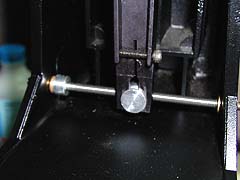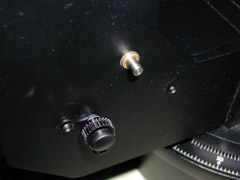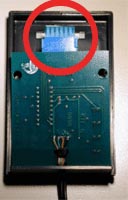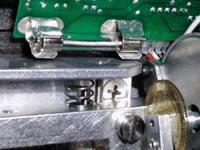Tag: lx50
Meade LX50 DEC Axis Issues
Hoo boy, did I have a sick DEC axis. l think I only started noticing it when I started guiding long-exposure shots as it was on the most part livable for the visual stuff. I had a few problems:
None of this is very good when you’re trying to guide a photo on a $%&# guide star you can barely see and I won’t even go into what an autoguider will try to do… Problem 1 was the easiest to solve. It was pretty obviously power related but after trying fresh batteries, NiCads, even a blasted 9v the “blinking light” weirdness persisted. After some good advice (always!) from the folks at SCT-User I decided to give it a go with a little 12v, 1A power brick. That did the trick and I’ve never had any problems since. Seems the problem is “The issue, as Rod said, is the gearing which loads the motor down. What is probably happening is the motor is loaded, its cold so it moves a little harder so the motor needs more current but as it gets more current, the voltage drops and the spiral is to stall the motor. You must realize that a DC motor uses MAX current at stall. As it goes faster it uses less current. The alkalines simply have to much internal resistance to play this game. As the current starts to rise, the alkalines voltage starts to drop…” Thanks for the explanation Phil. Since I do all my observing from my back yard this so far hasn’t been an inconvenience. Eventually I’m going to have to deal with powering the scope properly in the field but I’ll do a write up on that bag of beans when I have to face it! :o) |
 Problem 2 is the #1 gripe about the LX50’s DEC and whenever you mention you have a DEC problem with this scope on most newsgroups about 50 people will step forward and say in one voice: “Scopetronix LX50 DEC Fix Kit” [Link to the Internet Archive – Unfortunatley ScopeTronix went out of business some time in 2008.] I am now one of those people! 😀 Wow what a difference! I had never noticed how tacky and plasticy those Meade gears were until I had the kit installed on the scope. (I bought the 108 tooth aluminum gear version) In my opinion if you’re having DEC problems ordering the kit should be the first step. Mechanically the motors no longer “freeze” no matter what you do to them. You can stop the motor turning by grabbing the 108 tooth gear but let go and the motor just keeps on chuggin’ along. I was impressed already. As far as guiding is concerned the DEC speed is much slower and smoother. At 2x I now have to press and hold down the button on the key pad and just watch the star glide where before it was more like tap… Oh $%&# where’d it go?! Actually the DEC speed is now slower than the RA speed and as a matter of opinion that suits me just fine! At 32x for me the speed is still quite acceptable as I’ve always gone either straight for the DEC knob or just unlocked the thing to slew more than a few degrees anyway. A Final note on the motor revision and ROM version. Its stated on a lot of web pages including the Scopetronix page that the best combo is the 16 2/3 motor with the newer ROM (v6.0). My LX50 was bought in late 1999 and I have the newer 33 1/3 motor and the new ROM version and in my case the Fix Kit works great. So far I’ve guided a few shots with the kit installed but have yet to test it with the autoguider. |
Problem 3 didn’t take long to locate but I had a heck of a time figuring out how to cure! Even after installing the DEC Fix Kit I had a lot of back and forth motion along the long DEC screw the tangent arm attaches to.With the DEC locked I could grab the tube, shift it back and forth and watch the DEC knob move slightly in and out. I won’t begin to go into the amount of little corrections I tried to make or how many times I removed the DEC screw to try to figure out what was going wrong. Removing the DEC screw is a pretty basic procedure: With an allan wrench remove the DEC knob by loosening the screw that holds it in place. Do the same to the locking nut and push the tangent arm forwards (i.e. the OTA moves north) to disengage the DEC gears. When the gear is loose you can spin it easily until the threads run out on the nut attached to the tangent arm then just pull it out slowly. Do yourself a favor and note where all the little washers go, in which direction, etc. :o) I tried washers to take up the slack but all they would cause is binding making the motors work harder and make the DEC motion very irregular. Eventually I noticed the brass ring on the gear side (seen in the top picture with the 108 tooth gear removed) would be pushed out in one direction until it could go no further before the DEC arm would start to move and then be pulled back in when moving in the opposite direction. AHA! This little ring has a flange on one side that keeps it from sliding through the hole in the fork arm. I had the flange pointing _outwards_ and doing a pretty useless job of staying in one place when the screw would naturally try to push or pull against it as the locking nut is on the inside! So once again I took the whole thing apart so I could reverse the ring and see what would happen. In the second picture you can see the brass ring in a “corrected” position. There is a washer between the ring and the locking nut to keep the locking nut from binding. After about 2 seconds of slewing in DEC I was positive that this was the gremlin I had been hunting down. DEC motion was smooth in both directions and while the slack was a _lot_ less some was still there and probably could be reduced. With the DEC locked pushing the OTA in the N/S direction would produce minimal movement. The easiest way I found to reduce the movement that was left was simply to take a cheap pen apart and use the spring to push against the DEC knob. The spring takes up whatever slack is left and so far has done a really good job. There is no binding and the slack between directions is as small as I can make it without replacing the screw and nut with a finer more accurate thread. The spring should be fairly strong. I tried a couple of pens before deciding a spring that I pulled apart slightly so it would have a bit more tension. In the whole process experimentation is important and, as usual, YMMV (your mileage may vary)… |  |
 | |
 | |
 | |
 |
Meade LX50 Hand Controller Fix
 This happened to me on my 3rd night out with the scope and from what I’ve read elsewhere its a pretty common problem. Some of the keys didn’t work, the declination axis worked in one direction, etc… Don’t panic if this happens to you! All that’s going on is that a connector inside the hand controller has come loose. If you open up the controller it should be pretty obvious what’s going wrong. Remove the 2 screws on the back of the controller and pull off the back plastic panel. Inside you’ll find the printed circuit board connected to the front of the controller (where the keys are) by a blue connector. (Circled in red in the picture) This is what’s come loose. Just push it back in, pop the back on, screw it in place and everything should be fine again. I used some electrical tape over the connector and the back of the circuit board to keep it in place. The thing’s been fine since. |
Meade LX50 RA Axis Moves Slightly When Locked
This one really spooked me. I was finishing up for the night with a quick look at Orion. I aimed, locked the RA and DEC, and noticed that with the RA locked I could move the scope in a left-right motion very slightly. More or less half a centimeter of travel. Yikes! I took the scope inside and plonked it on the kitchen table with both the RA and DEC axis UNLOCKED. (This bit is very, very important! When you lay the scope on its side, you’re putting pressure on parts that weren’t make to take a lot of weight. If you have an axis locked you could force the scope and really break something.) The access panel to the RA drive motor is on the bottom of the scope and is held with 4 screws. Once you pop this off you’re looking pretty much at the heart of your LX50, so treat it like such and be very careful! One thing to steer clear away from is the encoder wheel. (In every picture on the right side) This controls the RA drive rate and breaking that means a $200 repair and at least a couple of weeks without your scope. ‘Nuff said. After fiddling with the motor system for a bit I noticed the problem was with a weird little screw. (Circled in red in the first picture) This thing basically keeps the spring mounted motor drive from traveling more than a certain distance. Through vibration, (my scope travels a bit), or general use, this thing was going off in its own direction: up! The space is a bit cramped for my fingers so using a flathead screwdriver and pushing it in a counterclockwise motion I managed to rotate the thing back down into place. (Second image) I didn’t like the idea of pushing it all the way back so I left a bit of space. (Last picture) I suppose this is the way the telescope is supplied. |  |
 | |
 |

























